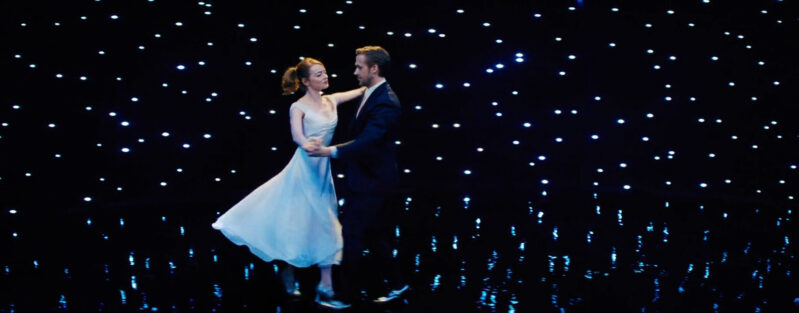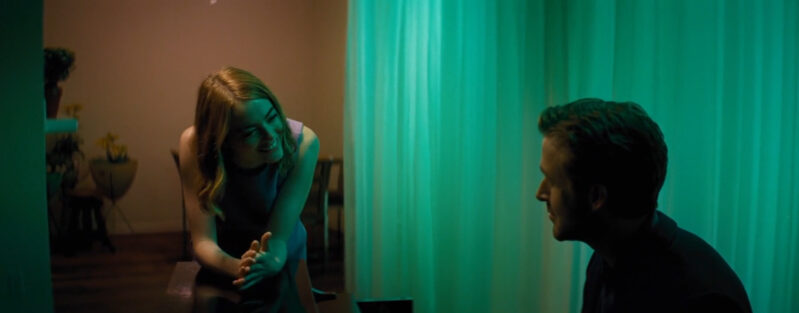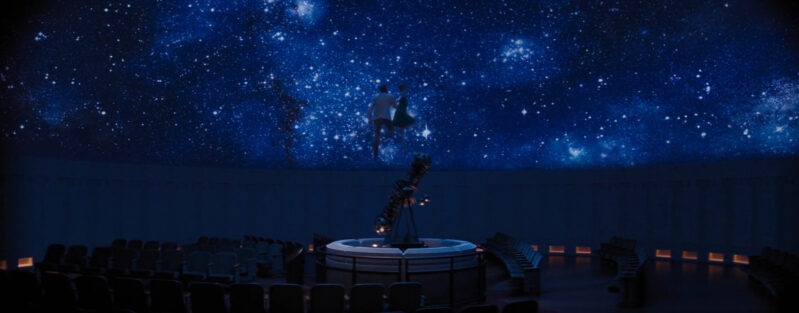What is La La Land about?
In La La Land, the deeper meaning lies in its exploration of the tension between dreams and reality, ambition and love, and the sacrifices that are often necessary in the pursuit of success. The film juxtaposes the bright, colorful world of Hollywood with the harsh, unforgiving nature of the entertainment industry, illustrating the challenges faced by those who dare to chase their dreams. The story of the two protagonists, an aspiring actress and a jazz musician, serves as a metaphor for the struggle that many artists face in their careers, and their tumultuous relationship underscores the sacrifices that often come with the pursuit of personal ambitions. Ultimately, La La Land highlights the bittersweet nature of life, where dreams and aspirations may not always align with reality, and love might be compromised in the quest for success.
Cast
- Ryan Gosling – Sebastian “Seb” Wilder
- Emma Stone – Amelia “Mia” Dolan
- John Legend – Keith
- J. K. Simmons – Bill
- Rosemarie DeWitt – Laura Wilder
- Finn Wittrock – Greg
- Callie Hernandez – Tracy
- Sonoya Mizuno – Caitlin
- Jessica Rothe – Alexis
- Tom Everett Scott – David
- Damien Chazelle – Writer and director
The ending of La La Land explained

A recap of La La Land‘s ending
In the ending of La La Land, the film jumps ahead five years after the main characters, Sebastian and Mia, have parted ways to pursue their respective careers. Mia has become a successful actress, married, and has a young child. Sebastian has realized his dream of opening his own jazz club, called “Seb’s.” One evening, Mia and her husband accidentally stumble upon Seb’s while looking for a place to have dinner.
As Mia and her husband enter the club, Sebastian, who is playing the piano on stage, recognizes Mia in the audience. The two make eye contact, and Sebastian starts to play a song that was significant to their relationship—the same song he played when they first met. The music triggers a montage, showing an alternate version of events where Sebastian and Mia stayed together and achieved their dreams as a couple.
In this alternate reality, Sebastian and Mia are still passionately in love, and they have a child together. Sebastian supports Mia’s acting career, and Mia helps Sebastian open his jazz club. They enjoy a life filled with love, music, and success. The montage also depicts them attending a premiere of Mia’s breakthrough movie together, showing their happiness and support for each other. The sequence ends with Sebastian playing the same song at his club, but this time, with Mia by his side, applauding and smiling.
As the song finishes, the film cuts back to the actual reality. Both Sebastian and Mia exchange bittersweet smiles, recognizing the life they could have had together. Mia’s husband returns from the bar, and Mia, holding her husband’s hand, leaves the club with him. Sebastian watches them go, a mixture of sadness and acceptance on his face.
In the final moments of La La Land, Sebastian begins to play another tune on the piano, and the camera pans out to reveal the club full of customers enjoying the music. Mia and her husband drive away, and as they reach a familiar intersection, Mia looks back at the view of the city that she once shared with Sebastian. The film ends with both characters looking off into the distance, accepting the reality of their separate lives and the sacrifices they made to achieve their dreams.
The meaning of La La Land’s ending
At the core of La La Land lies the struggle between ambition and love. Our two main characters are pursuing individual career paths: Mia as an aspiring actress, and Sebastian as a jazz musician. The film explores the challenges they face in achieving these goals, as well as the sacrifices they must make along the way. The movie’s ending delivers a powerful message about the nature of dreams and the importance of staying true to oneself. When Sebastian encourages Mia to attend a casting call that could potentially change her life, he demonstrates his unwavering support, even if it means putting their relationship at risk.
This climactic moment forces both characters to confront the consequences of their actions and the reality of the sacrifices they have made. The film’s final moments, set five years into the future, show that Mia and Sebastian have indeed achieved their dreams. Mia has become a successful actress, while Sebastian has opened his own jazz club. The realization is bittersweet, however, as they are no longer together.
The movie’s ending is made even more poignant through the inclusion of an alternate reality, where Mia and Sebastian imagine what their lives could have been like had they made different choices. This montage showcases the life they could have shared, filled with love, happiness, and support for each other. This “what if” sequence is a stark contrast to their actual lives, ultimately driving home the realization that dreams can come at the cost of love and personal relationships.
While the ending of La La Land offers resolution in terms of the characters’ aspirations, it leaves audiences with a sense of longing and wonder about their futures. Despite their success, the lingering question remains: Was the sacrifice worth it? The film invites viewers to consider their own dreams and the potential sacrifices required to achieve them.
The powerful imagery, dialogue, and storytelling throughout La La Land contribute to the emotional impact of the movie’s ending, leaving viewers to ponder the true nature of happiness and fulfillment. Ultimately, the film prompts the audience to question whether dreams and love can coexist, or if one must inevitably be sacrificed for the other. The characters’ journeys serve as a poignant reminder that life is a series of choices, each with its own set of consequences and rewards.
In the end, La La Land challenges the notion of a conventional “happily ever after” and instead embraces the bittersweet reality of life’s complexities. The film’s resolution encourages viewers to embrace both the joy and the sorrow that accompanies the pursuit of dreams and the sacrifices made along the way. By exploring these themes, La La Land leaves an indelible mark on its audience, encouraging them to consider the true meaning of happiness and fulfillment as they navigate the complexities of their own lives.
Why is the movie called La La Land?

The title of the movie La La Land carries a deeper meaning, serving as a metaphor for both the setting and the thematic essence of the story. The film revolves around the intertwining lives of two dreamers, an aspiring actress and a jazz musician, as they navigate the highs and lows of life in Los Angeles. This city, often referred to as “La La Land,” is a place where fantasy and reality collide. The title, therefore, encapsulates the movie’s exploration of the pursuit of dreams, the power of love, and the difficult choices one must make to achieve happiness and success.
La La Land uses the city of Los Angeles as a backdrop, a place notorious for its glittering facade and the allure of fame and fortune. The city itself symbolizes the dream world, a land where fantasies can become a reality but also where the line between illusion and reality is often blurred. The movie explores this duality in several scenes, such as the one where the aspiring actress auditions for various roles, only to face rejection after rejection. This highlights the harsh reality behind the glamour of the entertainment industry and the struggle one must endure to achieve their desires.
The title also points to the most prominent theme of the film: the pursuit of dreams. Both protagonists are dreamers, with one aspiring to be a successful actress and the other determined to open his jazz club. The phrase “La La Land” refers to a state of being out of touch with reality, often associated with being lost in one’s fantasies. This is exemplified by the many fantastical musical numbers throughout the film, which transport the characters and the audience into a world where everything seems possible. These surreal moments, such as the stunning dance sequence in the planetarium, underscore the power of imagination, while also serving as a reminder that reality can be less kind.
Another significant theme in La La Land is the transformative power of love. The protagonists’ love story unfolds as they navigate the challenges of chasing their hopes and desires. Their relationship acts as a driving force for their growth, pushing them to confront their fears and take risks. The title subtly captures this aspect as well, as “La La Land” could be interpreted as the euphoric state of being in love, where logic and reason are momentarily suspended. Love, like dreams, can be all-consuming and enchanting, but it can also require sacrifice.
Lastly, the title reflects the difficult choices the characters must make to achieve happiness and success. Throughout the film, the protagonists face multiple crossroads that force them to balance their aspirations and their love for each other. The bittersweet ending, where the characters achieve their fantasies but at the expense of their love, underscores the harsh reality that sometimes sacrifices are necessary. The title La La Land serves as a reminder that the pursuit of dreams and love can be beautiful and exhilarating, but also fraught with difficult choices and consequences.
The themes and meaning of La La Land

The pursuit of dreams
The pursuit of dreams is a central theme in La La Land, as the main characters, an aspiring actress and a struggling jazz musician, relentlessly chase their individual aspirations. The film explores the struggles, challenges, and sacrifices that the characters face of actualizing their ambitions.
Mia, the aspiring actress, attends audition after audition, attempting to break into the competitive world of Hollywood. The film illustrates her determination and passion for acting, as well as the countless rejections she faces. One memorable scene that highlights this theme is when Mia performs a one-woman play, which she wrote herself. The disappointing turnout temporarily causes her to give up. It isn’t until Sebastian reignites her passion that she’s able to rediscover it. This displays how determined one must remain in order to actualize their dreams.
Sebastian, the jazz musician, hopes to open his own jazz club and preserving the legacy of traditional jazz. His love for the genre is evident in the scene where he passionately explains its history and significance to Mia. However, in order to make ends meet, he is forced to take a job playing in a band that does not align with his musical vision. This demonstrates the sacrifices and compromises that one must make in the pursuit of their dreams.
The nature of love and sacrifice
The theme of love and sacrifice is inextricably linked to the pursuit of dreams in La La Land. The relationship between Mia and Sebastian serves as a catalyst for each character to strive for their aspirations while navigating the complexities of love and sacrifice.
Their love story is portrayed as a whirlwind romance, filled with moments of joy and tenderness. However, it is not without its challenges, as the characters face the reality of balancing their relationship and their ambitions. One pivotal scene that captures this struggle is when Sebastian misses Mia’s play due to a commitment with his band. This moment signifies the tension between personal and professional aspirations and the sacrifices that must be made for both to coexist.
The film’s ending is a poignant exploration of the theme of love and sacrifice. The characters ultimately choose to prioritize their career ambitions over their relationship, leading them down separate paths. The final scene, in which Mia and Sebastian share a knowing smile, suggests that their love remains, even though they have made the difficult choice to let each other go.
The power of nostalgia
La La Land is infused with a sense of nostalgia, not only for the golden age of Hollywood and jazz but also for the lost opportunities and roads not taken in life. This theme is evident in the film’s visual style, which pays homage to classic musicals, and in the music, which evokes the spirit of traditional jazz.
Sebastian’s character embodies the power of nostalgia, as his love for jazz is rooted in a deep reverence for the past. This is demonstrated in the scene where he takes Mia to a jazz club and passionately explains the significance of each instrument and the history of the genre. His desire to preserve this musical tradition showcases the power of nostalgia and its influence on his dreams.
The film’s ending further emphasizes the theme of nostalgia, as it presents an alternate reality in which Mia and Sebastian’s relationship flourishes alongside their professional success. This sequence is a bittersweet reflection on what could have been, highlighting the power of nostalgia in shaping our understanding of the past and present.
Important motifs in La La Land

Jazz music
Jazz music is another essential motif in the film. Jazz not only serves as the backdrop for Mia and Sebastian’s love story but also represents the passion, creativity, and authenticity that both characters strive for in their respective careers. Sebastian’s dedication to jazz is evident in scenes like his argument with Keith about the future of the genre and his dream to open a jazz club. The music itself also plays a significant role in shaping the film’s overall mood and atmosphere, with songs like “City of Stars” capturing the romance and magic of their love story.
Dreams and aspirations
Dreams and aspirations form a central theme in La La Land. Mia and Sebastian are portrayed as dreamers who are passionate about their respective crafts. Mia, an aspiring actress, struggles to land an acting role and create a meaningful career in Hollywood. Sebastian, on the other hand, dreams of opening his own jazz club. The film delves into the challenges of pursuing one’s dreams, as shown by the numerous auditions Mia goes through, as well as Sebastian’s financial struggles to maintain his artistic integrity. One significant moment that highlights this motif is when Mia performs “Audition (The Fools Who Dream),” illustrating the importance of dreams, no matter how absurd they may seem.
Vibrant colors
The use of color is a crucial motif in La La Land. The movie employs a bright and vivid color palette, which not only adds to its visual appeal but also serves to represent the emotions of the characters. For example, the colors of Mia’s dresses often match her emotional state: her yellow dress during “A Lovely Night” represents her blossoming feelings for Sebastian, while her green dress during “Someone in the Crowd” signifies her hope for success in Hollywood. The color palette also evokes a sense of nostalgia, connecting the movie to the classic Hollywood musicals it pays tribute to.
Nostalgia
Nostalgia is a recurring motif in La La Land, with the movie often paying homage to the golden age of Hollywood musicals. The film’s opening sequence, “Another Day of Sun,” sets the tone with a vibrant dance number reminiscent of classic musicals. This motif is also evident in the film’s visual style, such as the scene where Mia and Sebastian dance in the Griffith Observatory, reminiscent of the iconic scene in Rebel Without a Cause. Additionally, Sebastian’s passion for traditional jazz highlights his nostalgia for the past and his desire to preserve the purity of the genre.
Love and sacrifice
The movie explores the idea of love and sacrifice through the relationship between Mia and Sebastian. As the two fall in love, they also face the challenge of balancing their aspirations with their love for each other. A poignant scene depicting this motif is when Sebastian misses Mia’s one-woman play because of a photo shoot with his band, highlighting how the pursuit of dreams can sometimes demand personal sacrifices. Their ultimate decision to part ways so they can fully pursue their individual careers emphasizes the complex nature of love and the sacrifices it may require.
Questions & answers about La La Land

Why did Mia and Sebastian’s relationship ultimately fail?
The failure of Mia and Sebastian’s relationship is a central theme in La La Land. Their passionate love story is juxtaposed against their individual dreams—Mia’s pursuit of a successful acting career and Sebastian’s ambition to own a jazz club. As their careers progress, they make compromises that take them further away from each other. For instance, Sebastian joins Keith’s band to secure a stable income, which leads him to abandon his jazz ideals. On the other hand, Mia becomes increasingly dedicated to her acting career, culminating in her acceptance of a role in Paris. Their choices reflect the struggle many people face when trying to balance personal relationships and professional aspirations. The film poignantly demonstrates that, despite their deep love for one another, Mia and Sebastian’s dreams ultimately take precedence, and their relationship cannot withstand the strain of their diverging paths.
What is the significance of the final dream sequence?
The final dream sequence in La La Land is a powerful and emotionally charged moment that provides a glimpse into an alternate reality where Mia and Sebastian choose their love over their careers. As Mia visits Sebastian’s jazz club, they share a knowing glance, and the sequence unfolds as a montage of their life together if they had made different choices. The dream sequence is a nostalgic, bittersweet reflection of the life they could have shared, had they been willing to sacrifice their personal dreams. This alternate reality highlights the beauty of their love but also emphasizes the consequences of their choices. Ultimately, the dream sequence serves as a poignant reminder of the sacrifices both Mia and Sebastian made in pursuit of their ambitions, and the impact those sacrifices had on their relationship.
What role do colors play in the movie?
The color palette in La La Land plays a crucial role in creating the film’s distinctive atmosphere and contributes to the overall mood and themes. The use of bright, vivid colors evokes a sense of nostalgia, recalling the golden age of Hollywood musicals. The colors also symbolize the emotions experienced by Mia and Sebastian throughout their journey, such as the passionate reds and pinks during their romantic moments, or the dreamy blues and purples that represent their aspirations. The vibrant colors serve to enhance the emotions portrayed in the film, immersing the audience in the characters’ experiences. Moreover, the color palette underscores the film’s themes of love, dreams, and the struggle to balance personal relationships with career aspirations, creating a visually stunning representation of these complex emotions and experiences.
What is the role of jazz music in the movie?
Jazz music plays a pivotal role in La La Land, serving as a narrative device that drives the story and adds depth to the characters. For Sebastian, jazz represents his unwavering passion and ambition to preserve the art form he loves. His dedication to jazz music underscores the film’s themes of preserving art and culture amidst a rapidly changing world. Additionally, jazz music acts as a unifying force in Mia and Sebastian’s relationship, as they bond over their shared love for the genre. The music provides a backdrop for their love story and strengthens their emotional connection. Furthermore, the use of jazz in La La Land serves as an homage to the great jazz artists of the past, highlighting the importance of recognizing and celebrating the roots of this uniquely American art form.
Why is the song “City of Stars” important to the movie?
“City of Stars,” one of the most memorable songs from La La Land, is a reflection of the movie’s themes and the characters’ emotional journeys. The song explores the dual nature of Los Angeles as a place where dreams can come true or be crushed, mirroring the challenges Mia and Sebastian face in pursuing their ambitions. The lyrics express the hope and uncertainty they feel as they navigate the complex landscape of their personal and professional lives. “City of Stars” also serves as a romantic ode to their love story, capturing the enchanting moments they share together as they explore their feelings for one another. Furthermore, the song embodies the bittersweet nature of their relationship, as they ultimately choose their dreams over their love. For the audience, “City of Stars” becomes a poignant reminder of the sacrifices that often accompany the pursuit of one’s dreams and the delicate balance between love and ambition. The song’s melancholic melody and heartfelt lyrics evoke an emotional response, connecting the audience with the characters’ experiences and the movie’s central themes.
Now it’s your turn
Have more unanswered questions about La La Land? Are there themes or motifs we missed? Is there more to explain about the ending? Please post your questions and thoughts in the comments section! We’ll do our best to address every one of them. If we like what you have to say, you could become part of our movie guide!

